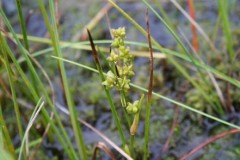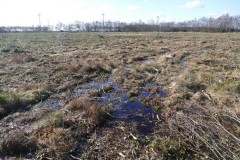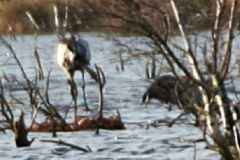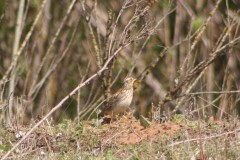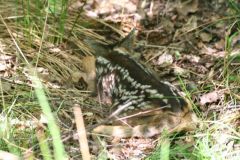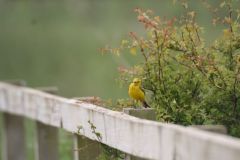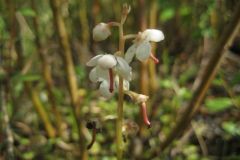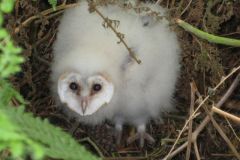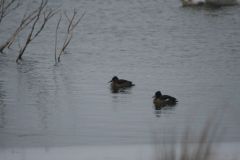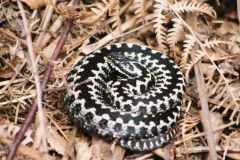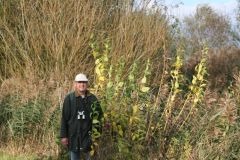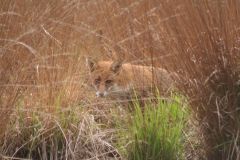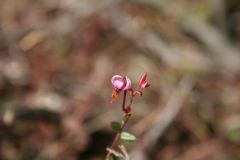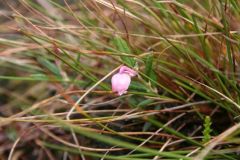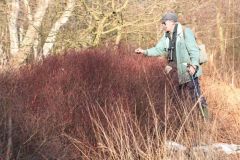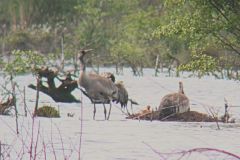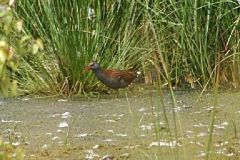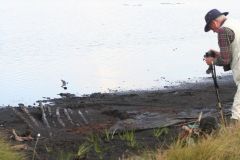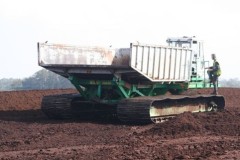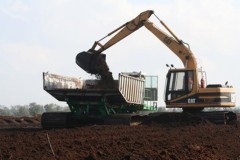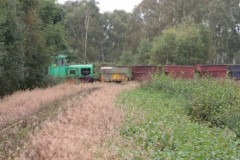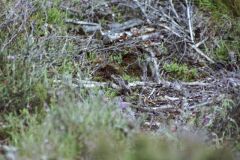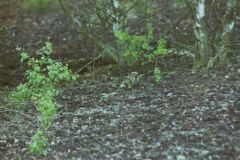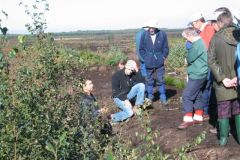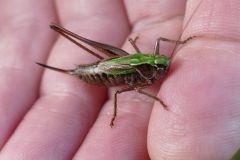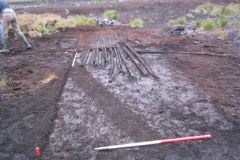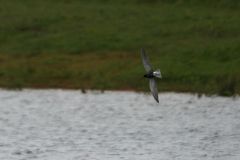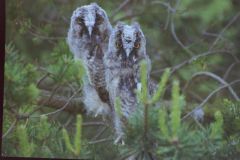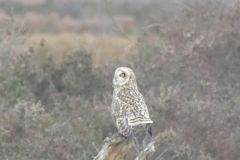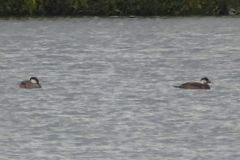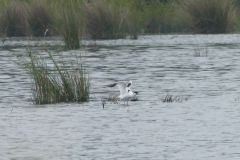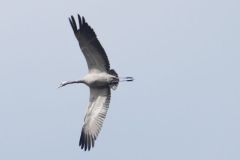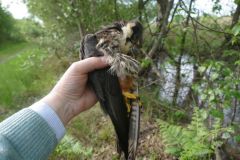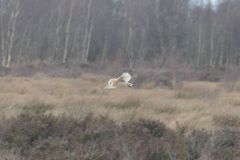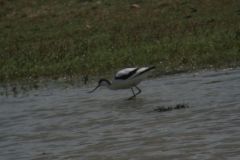DUNE HELLEBORINE—EPIPACTIS DUNENSIS.
During a recording visit to Thorne Moors on August 5th 2010 with Mick Oliver and Peter Bullock, I was walking slightly in front when I heard Pete say, that’s an Orchid. I had not seen the plant so I went back to look at it.
I recognised the plant as a species of Helleborine, Epipactis sp. The common species of Helleborine in the district is Broad-leaved Helleborine, E. helleborine. The leaf arrangement on the stem did not look like that of E. helleborine. The leaves were in two alternate rows instead of in a spiral, as in E. helleborine. The plant was in seed at the time. I took a photo of the plant and moved on.
In July 2012 I went back to the same area and took photos of plants which were in flower. By this time, word had reached Mark Lynes about the find. Mark went to look at the Helleborine and having examined a number of plants, determined it as Dune Helleborine, E. dunensis.
I had heard that Dune Helleborine had been found on Crowle Moor previously. On 27th June 1992 the Doncaster Naturalists Society paid a visit to Crowle Moors. One of the species looked for was Dune Helleborine.
The track was so overgrown with bracken that three members turned back. We did not find Dune Helleborine but we recorded Greater Hay Rattle, Rhinanthus angustifolius, Southern Marsh Orchid, Dactylorhiza praetermissa, Common Twayblade, Listera ovata and Bog Rosemary, Andromeda polifolia among the plants. Also seen were Ringlets and several Large Heaths on Brambles.
Note :- Mark Lynes has studied Helleborines and has travelled all over Europe in search of them. He has a particular interest (obsession) with E. dunensis and has visited most of the known UK populations. He is also the BSBI referee for Alchemillas.
Rannoch Rush – Scheuchzeria palustris.
1787 – Rannoch Rush is said to be first discovered in Britain, at Leckby Carr, near Boroughbridge.
1831 – It was found on Thorne Moors by Robert Harrison. William Casson, the Thorne Botanist and seed merchant was aware of the species near the South-Western area of Thorne Moors and used to take interested parties to see the plant. The site of the Rush was one of two “wells.” These wells are shown on early maps.
1870 – The last published record of Rannoch Rush on Thorne Moors was one by Dr. F.A.Lees.
1950 – From William Buntings Archive, he records seeing Rannoch Rush near ‘Spectacles Well’. He records that the site was destroyed shortly after.
2007 – 20th June I visited Rannoch Moor, Scotland in order to see and photograph a Rannoch Rush plant. Photographing the plant was done by balancing the camera on clumps of Cotton Grass to enable a close-up shot to be obtained.
Searching through various maps I traced Scheuchzeria Well to its location. I tried to access the site but Rhododendron ponticum, introduced by Casson, was impenetrable. After scrub clearance had taken place I again went to search the area.
2016 – On 23rd February I found Scheuchzeria Well at SE72941 13854. A few yards further north I also saw the Northern Well. These are marked on the an old map of the area.
Hatfield Moors Wildlife Observations (part 5).
19 March 2008 – Two male Ruddy Ducks at Boston Park Lake.
21 March 2008 – KB rang to say that two Cranes had been seen at Wroot.
23 March 2008 – A Woodlark was at Boston Park Lake.
12 April 2008 – Both Cranes were seen at the nest.
26 April 2008 – 12.50pm. The Cranes were disturbed by a walker and left the nest area. 1.10pm, the Cranes returned to the nest.
30 April 2008 – A Woodlark was seen on Packards Heath.
7 May 2008 – A Woodlark was by Boston Park Lake.
10 May 2008 – The Crane on the nest turned the eggs about once an hour.
12 May 2008 – Ken Milner (on guard duty) said that both eggs had hatched.
6 August 2008 – Both adult Cranes and two juveniles were seen flying.
1 October 2008 – One Ruddy Duck seen in the Boston Park area.
19 November 2008 – A Red Kite was seen flying West.
A Pair of Ruddy Ducks near Badger Corner Lake.
21 February 2009 – I was with John Wozencroft at Badger Corner when John pointed to a male Hen Harrier flying past.
12 March 2009 – A Woodlark was singing at Packards Heath.
18 March 2009 – Woodlark singing at Packards Heath.
2 April 2009 – Two Woodlarks were seen.
25 March 2009 – Two Cranes were seen on site.
4 April 2009 – Both Cranes at the nest. Two eggs were seen.
Cranes and eggs.
8 April 2009 – Woodlarks seen on Packards Heath.
9 April 2009 – Two Woodlarks were seen at Boston Park Lake.
Woodlark
22 April 2009 – Woodlark seen at Boston Park Lake.
7 May 2009 – While Mick and myself were walking through birch trees near Boston Park Lake we disturbed a female Roe Deer. Instead of running away it went a few yards then stopped and turned to watch us. We took a few paces forwards then saw its fawn laying on the ground motionless. We took a couple of photos then withdrew.
Roe Deer Fawn
4 June 2009 – When driving away from the Boston Park car park I noticed a Yellow Wagtail on the fence.
Yellow Wagtail.
16 August 2009 – I was shown Creeping Willow near Boston Park lake by Helen Kirk. It had been found by Brian Eversham. Next to the Willow was a flowering plant of Round Leaved Wintergreen I reported the find to Don Grant, the YNU VC 63 plant recorder. It was thought that this was a new South Yorkshire record. Mick has recently reminded me that someone had introduced plants from Scotland into the Dragonbacks area, near Boston Park lake. It seems likely that the Wintergreen was one of these introductions.
Round-leaved Wintergreen (Pyrola rotundifolia).
15 October 2009 – Three Woodlarks were seen at Spinney Corner. The Trackway has been covered by a large mound of peat.
24 March 2010 – Two Cranes were on site. A Woodlark was calling.
1 April 2010 – Richard said he had seen an Otter near the factory on Hatfield Moors.
16 April 2010 – I was walking along the River Torne bank near Wroot when I noticed a very large bird flying away from the edge of Hatfield Moors. The birds plumage was a mottled brown. As the bird got closer it started to climb, without flapping its wings. It circled around in a thermal, gaining height and slowly heading South. The birds head and tail seemed small compared to its wings. As it circled, the sun highlighted the birds head, which looked either white or very pale. I described the bird to the recorder and was told it was a Sea Eagle.
21 April 2010 – I saw a Chinese Goose and an Embden Goose by the Prison Lakes.
Chinese Goose and Embden Goose.
Some time in early Summer 2010 we found a large nest box in a pine tree.
14th July 2010 – We were at the site again and found a juvenile Barn Owl at the foot of the tree. At the time it was said that if you found an Owl out of a nest box it was best to leave the bird where it was. We did this. On the next visit we found the remains of the bird under the tree.
Barn Owl juvenile.
1 March 2012 – A male Goldeneye was seen on Badger Corner lake.
11 February 2012 – I observed a female Ring Necked Duck on Boston Park Lake.
Ring Necked duck on left with female Tufted Duck.
5 October 2012 – I heard that Crested Pochards had been seen at Boston Park lake. I managed to see a male and either two females or a female and a juvenile.
Red Crested Pochards at Boston Park Lake.
Adders were seen fairly often This coiled male was near Whites Corner.
Male Adder.
Hatfield Moors Wildlife Observations (part 4).
30 October 2006 – On the moor with Colin Wall, walking down the track towards Badger Corner we came across a stand of Jerusalem Artichoke.
25 April 2007 – Having paused for a drink, with Mick, in tall grass a fox approached the site, not having seen or heard us. I managed to get a photo before it realised we were there and ran off.
23 May 2007 – On Packards Heath we found Cranberry (Vaccinium oxycoccos).
28 May 2007- A pair of Gadwall were seen in a drain near Scotts factory.
8 June 2007 – Female Gadwall and 7 chicks seen on lily pond near Richard’s farm.
20 June 07 – Several stems of Bog Rosemary (Andromeda Polifolia) were also found on Packards Heath.
Hatfield Moors Wildlife Observations (part 3).
7 February 2007 – Mick & I were in the North-West corner of the moor when we came across Bog Myrtle plants growing in a deep ditch. The plants were much taller than usual. On the next visit to this area the water level in the ditch had risen. This explained why the plants were taller. We had a discussion about whether Bog Myrtle flowers were monoecious or dioecious. Looking at the plants closely the result was inconclusive.
Mick Oliver with the tall Bog Myrtle (Myrica gale) plants.
13 March 2007 – Went to the moor through Richard and Marjorie Lyons farm with Colin Wall. Marjorie told us that there were two Cranes outside their house this morning.
7 April 2007 – The Cranes were nest building. This consisted of the birds pulling pieces of wood out of the water with their beaks and throwing it into a pile.
9 April 2007 – One Crane sat on the nest. The water level was high and one corner of the hide was flooded. A Water Shrew swam through the hide. A male Hen Harrier flew past the hide.
11 April 2007 – Now at Belton Moor, a Northern section of Hatfield Moors. More plants of Bog Myrtle seen. We found several with female flowers.
Female flowers of Bog Myrtle (Myrica gale) .
14 April 2007 – Both Cranes were at the nest. Two eggs were seen.
18 April 2007 – Belton Moor again. Bog Myrtle with male flowers found.
Bog Myrtle (Myrica gale) male flowers.
21 April 2007 – Driving off the moor through Richards I saw a Squirrel carrying a juvenile Squirrel in its mouth. Met John Wozencroft, he reported the Red Necked Grebe was at 10 acre lake.
22 April 2007 – Saw Red Necked Grebe and Kingfisher at 10 acre lake.
9 May 2007 – Both adult Cranes at the nest. One chick seen.
10 May 2007 – KB rang to say two chicks were seen.
11 May 2007 – Both adult Cranes seen walking with chicks swimming along behind.
13 June 2007 – A Water Rail with chicks seen near the peat factory. The chicks were keeping close to cover.
Water Rail
Also noticed two Cranes which seemed to be pecking at the ground. We went to see what they were doing after they flew off. We found an Ants nest which had been disturbed.
20 June 2007 – We heard that Large Heath had been seen so went to Packards to see if we could find any. Mick saw one first and we managed to get some photos.
Large Heath on Packards.
Photos were sent to Tim Melling. (I think his thesis was on the Large Heath). Tims opinion was that the Large Heath was not a local sub-species but one from further south. May be a possible introduction by the Worksop lepidopterist. (It may be a useful project for the Nats to see if Large Heath is still present on Packards Heath?)
4 July 2007 – After a period of rain there was a good deal of water in the Kilham West area. Paddling about I came to a raised area with an Adder on it. The Adder started hissing and would not move so I had to walk around it.
12 September 2007 – We visited the Trackway. It seemed to be in a poor state.
Mick Oliver photographing the Trackway.
Hatfield Moors Wildlife Observations (part 2).
19 April 2006 – Both adult cranes are at the nest
29 April 2006 – I saw three Avocets fly past the hide from the North.
23 May 2006 – Both adult cranes and one chick were seen over on the West bank feeding.
27 July and 5 August 2006 – a Red Necked Grebe was observed on 10 acre lake.
Red Necked Grebe on 10 Acre Lake.
11 July 2006 – One Ruddy Duck was seen on moor.
30 August 2006 – Two adult Cranes and one juvenile seen.
Scotts, the american company that took over peat removal from Hatfield Moors were allowed to remove peat which had already been stacked on the moor, ready for removal. The next five images show the last of the peat being removed from the site, followed by the dismantling of the small gauge railway.
Hatfield Moors Wildlife Observations (part 1).
During several years of Botanical recording on Hatfield Moors, often in the company of Mick Oliver, other wildlife was seen. The following notes are a record of some of the species seen and entered in my field notebook.
My first records for Hatfield Moors were from 16 June 1999. Here, I recorded Green Woodpecker, Turtle Dove, Ruddy Duck, Coots, Swans, Woodcocks, Nightjars, Tawny Owl and Fox.
18 September 2004 – my sister noted many Cornflower plants in a carrot field at Candy Corner as we were driving past.
My regular recording on Hatfield Moors began on 28 April 2005, when a female Crane was seen. I was told the difference between the sexes was that the male was slightly larger and had a darker tail.
4 May 2005 – I noted that a female Crane was sat on a nest.
5 May 2005 – I was on the moor when a Land Rover drove up. The driver was Kevin Bull (the Site Manager) and his passenger was Martin Limbert (Doncaster Museum). After a discussion Kevin asked me if I would be prepared to help guard the Crane nest site to prevent disturbance from people walking about. Later that day I heard a Grouse calling East of the Island.
We volunteered to keep watch on the site of the Cranes nesting area and ask people to leave the area if seen in its proximity. In order not to disturb the birds we constructed a small hide which we could approach without the birds seeing us. This also afforded us a good view of the nest. Other people were also involved in guarding the site in rotation with us.
14 May 2005 – I saw three Black Necked Grebe on 10 acre lake.
17 May 2005 – I was driving from the moor along Moor Dike Road, near Hollinbridge, when I noticed a Lesser Spotted Woodpecker flying alongside. It landed at the top of an Oak tree and began to search among the branches, after that the bird was lost from sight.
20 May 2005 – I visited 10 acre lake. Two Black Necked Grebe and a male Ruddy duck were present.
23 May 2005 – Kevin Bull rang to say he had observed both adult Cranes and one chick.
9 June 2005 – On a visited Boston Park car park I was asked if I had seen the Black Tern; some minutes later I did see the bird.
Also, a pair of juvenile Long-eared Owls were seen by Tim Melling, Helen Kirk and myself on Packards.
25 August 2025
Some photos from Thorne Moors
From top left they are, short eared owl, pintail, common scoter, water pipit, merlin, avocet, wheatear, little egret, turtle dove.
From top left red kite, black necked grebe, crane, dead hobby, hobby, marsh harriers, crane displaying, male hen harrier, barn owl.
Thorne Moors bird sightings.
Birds that are less commonly seen on Thorne Moors, recorded by the author.
Anyone who is not familiar with Thorne Moors, and has never visited the site, will not be aware of the importance of the area. Thorne Moors is the largest area of raised bog in England, covering an area of 1911 hectares. The Moors have been designated a Special Protected Area and a Special Area of Conservation. Thorne Moors are also a Site of Special Scientific Interest.
Thorne Moors would have been destroyed by the Horticulture industry for compost if it were not for the campaigning started by Thorne naturalist William Bunting.
The site contains an array of habitats from peat bog, lagoons, waterlogged ditches, heath, tracks, scrub and woodland. This in turn attracts an enormous range of wildlife species, many of which are rare.
Much has been written about Thorne Moors and the wildlife that live on and visit the site. Recording and studying the wildlife and habitats of Thorne Moors is on-going by both amateur and professional naturalists. Most visitors to Thorne Moors venture no further than the Southern Canals area. There is so much more to explore and see.
As Peter Skidmore once said, “the wildlife of Thorne Moors is exceptional, but you have to work for it.”
The following is the result of casual observations made during a series of visits by me, a non-birder. The list contains the records of birds which I consider un-common on the Moors.
Bittern, 8 records, single bird booming on most occasions. On March 19th 2020 two birds were calling.
Short Eared Owl, 22 records, mostly at dusk.
Pintail, 4 records, usually a coastal species.
Merlin, 7 records, our smallest falcon inhabiting moorland, marshland and coastal areas.
Turtle Dove, 5 records, mixed habitats and sadly, now decreasing in numbers.
Avocet, 1 record, not so many years ago this species was a rare sight in the UK, now becoming more widespread.
Water Pipit,2 records, an uncommon Winter visitor.
Little Egret, 3 records, once uncommon in the UK, now seen frequently.
Red Footed Falcon, 3 records, a rare visitor to the UK
Common Scoter, 1 record, mainly a coastal species.
Whinchat, 1 record, mixed habitats.
Raven, 1 record, becoming more common.
Red Breasted Merganser, 2 records, not common in the area.
Montagu’s Harrier, 2 records, an uncommon species.
Wheatear, 5 records, mixed habitats, a Summer visitor and sometimes seen on passage.
Red Kite, 4 records, once nearly extinct but now widespread due to introductions.
Bearded Tit, 9 records, although fairly common not easily seen among reed-beds.
Black Necked Grebe, 6 records, inhabits shallow water. Has bred here.
Cetti’s Warbler, 32 records. Once a rare visitor to the area, now becoming fairly common. This bird is more often heard than seen, with its loud call coming from the depths of bushes.
Common Crane, many records from the site. A few years ago this species was introduced into East Anglia, but these local birds were not introduced. Their trumpeting call can be heard from a great distance.
Marsh Harrier, seen on most visits. Inhabits marshes with reed beds, and usually hunts low and then swoops on prey.
Hobby, many sightings from mid-Spring until Autumn. A good vantage point to watch Hobby’s hunting is from the viewing platform on the Moors. A dead Hobby was found on 18/5/2017. Cause of death unknown.
Hen Harrier, a much persecuted bird. Frequents heather moorland, mainly an upland species.
Barn Owl, usually seen at dusk, hunting low.
Ian
Thorne Moors Bird Records.
Bittern, heard booming. Recorded with Martin Warne.
6/1/2016.
13/4/2016.
20/4/2016.
27/4/2016.
28/4/2016.
5/4/2018.
11/4/2018.
19/3/2020 x 2.
Short Eared Owl.
Recorded with Martin Warne and Helen Kirk.
23/2/2016
16/3/2016.
22/3/2016.
13/4/2016.
20/4/2016.
1/11/2017.
7/3/2018
22/3/2018.
5/4/2018.
21/2/2019.
27/2/2019.
21/3/2019.
27/3/2019.
15/10/2019.
31/10/2019.
13/11/2019.
19/11/2019.
26/11/2019.
28/11/2019.
5/12/2019.
12/2/2020.
3/3/2020.
Pintail.
28/11/2018.
23/1/2019.
11/12/2019.
2/1/2020.
Merlin.
Recorded with Martin Warne.
23/2/2016.
12/10/2016.
26/12/2018.
28/3/2019.
21/1/2020.
17/3/2020.
22/9/2020.
Turtle Dove.
21/6/2017.
13/6/2018.
8/8/2019.
3/9/2019.
30/6/2020.
Avocet.
16/6/2020.
Water Pipit.
10/3/2020.
12/3/2020.
Little Egret.
Recorded with Martin Warne.
3/9/2019.
30/6/2020.
6/8/2020 x 2.
Red Footed Falcon.
Birds pointed out by birders on site.
12/5/2016.
3/5/2017.
1/5/2019.
Common Scoter.
22/10/2016 x 2.
Whinchat.
3/9/2019.
Raven.
Seen with Helen Kirk.
3/4/2019 x2
Red Breasted Merganser.
26/12/2018. 1 Female.
22/10/2019.
Montague’s Harrier.
3/5/2018.
27/8/2019, juvenile pointed out by Martin Warne.
Wheatear.
28/4/2016.
5/5/2016 x2.
17/8/2016.
31/8/2016.
3/9/2019.
Red Kite.
3/9/2019.
5/3/2020.
14/7/2020.
16/7/2020.
Bearded Tit.
23/1/2019.
30/1/2019.
20/3/2019.
17/10/2019.
31/10/2019.
13/11/2019.
20/2/2020.
3/3/2020.
19/3/2020.
Black Necked Grebe.
3/6/2018.
3/4/2019.
24/4/2019.
1/5/2019.
15/5/2019.
29/5/2019.
Cetti’s Warbler.
16/12/2015.
6/1/2016.
16/3/2017.
3/5/2017.
18/5/2017.
21/6/2017.
6/9/2017.
25/10/2017.
11/1/2018.
7/3/2018.
18/4/2018.
3/5/2018.
31/5/2018.
13/6/2018.
20/6/2018.
3/10/2018.
17/10/2018.
23/1/2019.
6/3/2019.
21/3/2019.
27/3/2019.
28/3/2019.
4/4/2019.
24/4/2019.
2/5/2019.
27/5/2019.
23/7/2019.
8/8/2019.
26/9/2019.
17/10/2019.
22/10/2019.
31/10/2019.
Common Crane.
Cranes were either seen or heard on many visits.
Marsh Harrier.
Marsh Harriers are frequently seen on site.
Hobby.
Seen from Spring to early Autumn all years.
Hen Harrier.
Sightings from October 2016 to February 2020.
Barn Owl.
13/11/2019.
19/11/2019.
26/11/2019.
28/11/2019.
23/12/2019.
21/1/2020.
12/2/2020.
18/2/2020.
3/3/2020.
26 February 2025
I was looking at The Naturalist, the YNU publication, issue Vol. 145, no. 1104, August 2020. In a paper by Martin Limbert and Tim Melling, it was discussing the return of Avocets to the UK.
It reminded me of when I saw Avocets breeding at Huggin Carr sand and gravel quarry near Hatfield Moor. I was told that Avocets were there and walked along the Bridleway from Boston Park farm. I could not see the birds so I decided to approach the quarry from the other side.
The site was being developed into a lakeside lodge area. I spoke to the person in charge and was given access to look at the Avocets. They were on a low island quite a way from the shore. I think there were six pairs but I,m not certain. I did not keep any records. Some of the Avocets were sitting down, on eggs?
I visited the site between 26/5/2012 and 4/6/2012. I noticed a number of chicks walking along the far edge of the island. Sometimes the chicks were with an adult, at other times they were on their own. There were Black-headed Gulls flying around and I thought the chicks would be attacked but the gulls ignored them.
I have just looked at the site using Bing Maps and it looks like the island has been removed or landscaped. Image 3159 shows some of the Avocets. Image 3021a shows an adult with two chicks and image 3188 shows an adult.
I thought this might be of interest to the members.
Ian.



